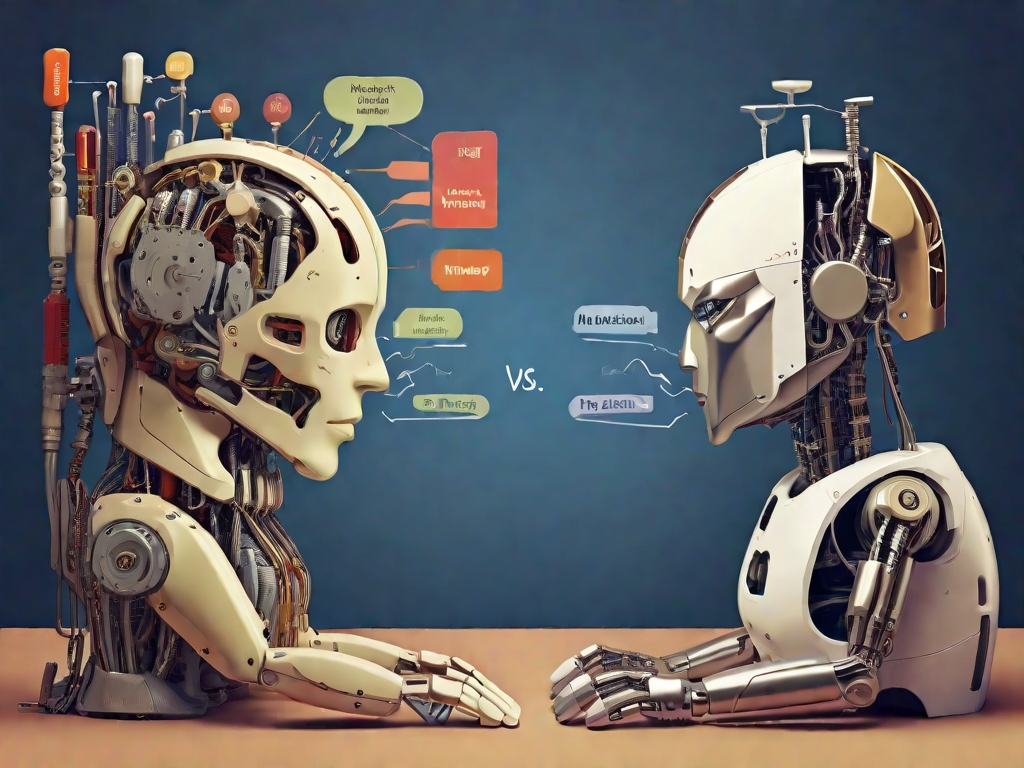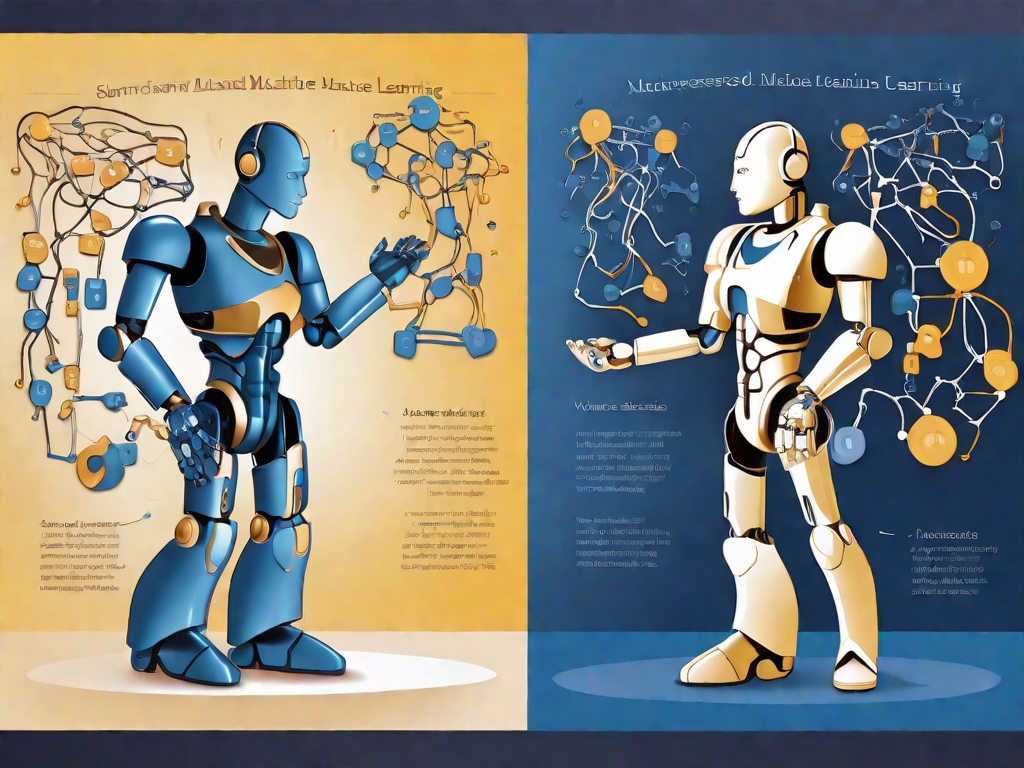Supervised vs unsupervised learning represents two core approaches to training machine learning models. In this comprehensive guide, we’ll explore how they differ, their use cases and applications, key algorithms, performance evaluation, and more. Grasping these fundamental learning paradigms provides a strong foundation in machine learning.

What is Supervised Learning?
Supervised learning is a machine learning approach that trains models to make predictions using labeled data. The training data consists of input examples mapped to known target outputs. The model learns by examining many input-output pairs to find relationships between the features and targets.
Once trained, supervised models can take new unseen inputs and infer the correct output using patterns learned from the historically labeled data.
Some common supervised learning tasks include:
- Classification: Assign observations to discrete categories, like labeling images with object classes.
- Regression: Predict a numerical value output, like anticipating house prices.
- Transcription: Convert sequences from one representation to another, such as speech recognition.
Supervised learning is ideal for forecasting outcomes, classifying data into predefined taxonomies, or any setting where example input-output mappings exist. It finds broad applicability in fraud detection, speech recognition, targeted marketing, medical diagnosis, and more.
Algorithms Used in Supervised Learning
Many specific machine-learning algorithms fall under the umbrella of supervised learning. Popular choices include:
- Linear regression – Fits a linear model to numeric prediction tasks.
- Logistic regression – Applies regression but with a discrete classification output.
- Decision trees – Create rulesets for classification based on feature thresholds.
- Random forests – Ensemble method combining predictions from many decision trees.
- Support vector machines – Find optimal hyperplanes between classes of data.
- Neural networks – Multilayer models that learn complex relationships between features and targets.
In practice, techniques like neural networks, gradient-boosting machines, and random forests tend to achieve state-of-the-art results on many supervised learning challenges.
The Supervised Learning Process
Developing a supervised learning model involves several key steps:
- First, assemble a training dataset containing many input-output examples.
- Clean and preprocess data to handle outliers, missing values, and categorical variables.
- Select informative features to represent each input example. This may involve dimensionality reduction methods like PCA.
- Choose a suitable supervised learning algorithm based on the size and structure of the data.
- Train the model by showing it input-output pairs and allowing it to iteratively improve its predictions.
- Assess model accuracy on new test data not used in training.
- Tune model hyperparameters and pipelines based on their generalization performance.
- Deploy the model to make predictions in the real world. Monitor and periodically retrain on new data.
The availability of many labeled examples is critical to success in supervised learning. Models learn best when provided substantial historical cases mapping inputs to targets.
Unsupervised Learning Overview
In contrast to supervised learning, unsupervised learning does not rely on labeled data. The models are fed unlabeled datasets and left to discover patterns and groupings on their own without human guidance.

Some key unsupervised learning tasks include:
- Clustering: Automatically group similar data points into categories. Ex: Customer segmentation.
- Association rule learning: Discover if-then relationships within data. Ex: Grocery purchases.
- Dimensionality reduction: Simplify high-dimensional data into fewer dimensions. Ex: Image compression.
Since no training targets are given, unsupervised models do not make predictions. They simply uncover structure and relationships within the data itself.
Unsupervised learning suits domains with few existing labels or taxonomy. It also facilitates exploratory data analysis to derive novel insights. Common applications include anomaly detection, recommender systems, and social network analysis.
Major Unsupervised Learning Algorithms
Prominent unsupervised learning algorithms include:
- K-means clustering: Forms k groups from data points minimizing in-group distances.
- Hierarchical clustering: Builds a hierarchy of nested clusters using distance metrics.
- Apriori algorithm: Uncovers frequent itemsets and association rules between variables.
- Principal component analysis (PCA): Statistical technique for dimensionality reduction.
- Singular value decomposition (SVD): Matrix factorization method for latent semantic analysis.
- Self-organizing maps: Low-dimensional projections that preserve the topology of high-dimensional inputs.
Autoencoders and restricted Boltzmann machines used in deep learning can also perform effective unsupervised feature learning from complex unstructured data like images.
Unsupervised Learning Workflow
Developing an unsupervised learning solution typically involves:
- Acquiring suitable unlabeled training data that is representative.
- Cleaning and preprocessing data as needed into a suitable format.
- Performing exploratory data analysis to identify initial patterns and relationships.
- Applying clustering, dimensionality reduction, or other unsupervised models to the dataset.
- Validating that the model effectively captures the underlying structure within the data.
- Interpreting model outputs to derive actionable insights.
- Iteratively refining approach based on analytic needs.
Because no training targets exist, assessing unsupervised models requires subject matter expertise and business understanding. Statistical metrics can help surface useful versus spurious patterns.
Key Differences: Supervised vs Unsupervised Learning
While both powerful paradigms, supervised and unsupervised learning differ considerably:
| Supervised Learning | Unsupervised Learning |
|---|---|
| Uses labeled data | Uses unlabeled data |
| Generalizes to new data | Just explores inherent dataset patterns |
| Guidance on desired outputs | No guidance on outputs |
| Predictions and inferences | Just associations and descriptions |
| Classification, regression | Clustering, dimensionality reduction |
Labeled vs. Unlabeled Data
Supervised learning uses labeled data containing both inputs and desired outputs. Unsupervised learning accepts only unlabeled input data.
Prediction vs. Description
Supervised learning infers predictions about new data. Unsupervised finds patterns in existing data but does not predict.
Classification vs. Clustering
Supervised models classify data into provided categories. Unsupervised models cluster data based on their intrinsic similarities.
Training Process
Supervised models train towards known targets iteratively. Unsupervised models identify emergent patterns in an open-ended fashion.
Performance Metrics
Accuracy, precision, and recall are key for supervised models. Unsupervised uses metrics like cluster cohesion to validate usefulness.
Model Flexibility
Supervised models perform a predefined task. Unsupervised explores the data to uncover any useful structure within it.
Prior Knowledge
Supervising requires understanding target categories and outputs. Unsupervised works on unfamiliar data where the model must identify latent patterns from scratch.
Labor Intensity
Supervised needs substantial labeled data. Unsupervised can work with raw data as-is but requires interpretation.
In summary, supervised learning makes predictions from examples while unsupervised models elucidate the intrinsic structure of the data itself.
Natural Language Processing Vs Machine Learning: Explained
Comparing Key Use Cases

To better understand when each approach shines, let’s compare some common applications of supervised and unsupervised learning:
Fraud Detection
- Supervised models would classify transactions as fraudulent or not based on labels of past data. Features may assess transaction risks.
- Unsupervised models would uncover anomalies and clusters within transaction data. New fraudulent patterns may emerge that deviate from historical fraud.
Image Recognition
- Supervised CNN models will categorize images into known labels like ‘cat’, ‘dog’, ‘car’ etc. Many labeled samples train the classifier.
- Unsupervised models can segment images based on pixel similarities. This allows searching images with similar visual patterns without knowing category labels.
Customer Churn Prediction
- Supervised classifiers predict whether customers will churn using past examples of retained and churned clients. Features summarize customer tenure, activity, saturation, etc.
- Unsupervised techniques could cluster customers into groups of inherently similar behavioral profiles. Differences between retained vs. lost customer clusters can be studied.
Product Recommendations
- Supervised learning provides personalized suggestions based on correlations between customer attributes and purchase history.
- Unsupervised methods like association rule mining reveal which products customers frequently purchase together from implicit patterns alone.
As you can see, supervised is preferred when making predictions based on historically labeled data. Unsupervised uncovers new insights into the data itself without classifications imposed.
Semi-Supervised Learning
Semi-supervised learning combines supervised and unsupervised learning. A small labeled dataset trains an initial model. Then unlabeled data is leveraged to improve model accuracy beyond what the limited labeled data can provide.
This addresses scenarios where obtaining large training sets is expensive but unlabeled data is abundant. Semi-supervised algorithms can complement small labeled datasets with unsupervised learning on bountiful unlabeled data.
Example techniques include deep belief networks that first pre-train in an unsupervised manner to initialize a neural network before supervised fine-tuning. Semi-supervised approaches can combine the strengths of both paradigms.
Evaluating Model Performance
Since supervised models predict specified targets, measuring predictive accuracy is vital. Common evaluation metrics for supervised models include:
- Accuracy – Percentage of correct predictions overall
- Precision – Correct Positive predictions
- Recall – Actual positive cases correctly classified
- F1 score – Balance of model precision and recall
- AUC – Area under ROC curve tracks true vs false positive rate tradeoffs
- Squared error – For regression, deviation between predicted and actual numeric values
For unsupervised models, it is harder to assess quality quantitatively since no labeled ground truth exists. Useful methods include:
- Comparing cluster statistics against domain knowledge benchmarks
- Assessing cluster cohesion using metrics like the Silhouette coefficient
- Examining model interpretation and business utility based on expertise
- Reduced reconstruction error in deep autoencoders
- Statistical analysis of model stability across conditions
- Evaluating dimensionality reduction performance via data visualization
Ultimately unsupervised learning requires human judgment. Statistical rigor combined with qualitative assessment provides a well-rounded perspective into model value.
When to Use Each Approach
So when should you apply supervised versus unsupervised learning for a machine learning initiative? Here are some general guidelines:
Use supervised learning when:
- Labeled training data is available, or labels can be obtained cost-effectively.
- The problem is well-defined. You know the predictive variables and outputs to train towards.
- New data resembles past examples. Patterns will remain stable over time.
- Maximum predictive accuracy is needed.
Use unsupervised learning when:
- No historical labels exist and acquiring them is infeasible.
- Exploratory data analysis can provide novel insights and hidden relationships.
- The problem is ambiguous with unclear target variables.
- Only intrinsic data patterns are of interest, not future predictions.
For many problems, trying both supervised and unsupervised techniques in parallel provides useful complementary perspectives. The two approaches can work together to strengthen overall results.
Real-World Applications
Now let’s examine how supervised and unsupervised learning are applied in practice across different industries:

Fraud Detection
- Supervised models trained on labeled legitimate and fraudulent transactions to flag suspicious activity.
- Unsupervised models identify anomalies and change fraud patterns over time.
Healthcare
- Supervised techniques diagnose patients and recommend treatments given labeled historical data.
- Unsupervised learning analyzes patient subgroups and personalized medicine applications.
Manufacturing
- Supervised methods to optimize manufacturing processes and quality control based on target equipment metrics.
- Unsupervised learning helps segment products and production chains to identify inefficiencies.
Marketing
- Supervised learning forecasts buyer propensity and microsegment customers to refine targeting.
- Unsupervised models find novel customer affinities and brand association patterns from sales data.
Across domains, the two approaches provide complementary strengths suitable to different analytic objectives. Both serve indispensable roles in real-world machine-learning pipelines.
Looking Forward To Future
As datasets grow ever larger and more complex, supervised and unsupervised techniques will need to evolve as well. Key developments on the horizon include:
Requiring Less Labeled Data: Semi-supervised, self-supervised, and active learning approaches minimize the amount of manual labeling needed.
Handling Diverse Data: Models that work across modalities (text, images, video, audio) and data types will be increasingly valuable.
Focusing on Feature Representations: Better automated feature learning through techniques like autoencoders and representation learning.
Achieving On-Device Learning: Enable training directly on edge devices with limited data using federated learning.
Improving Interpretability: Make model behavior and predictions more explainable to users especially in sensitive applications.
Streamlining Workflow: Automate more parts of the machine learning lifecycle from data management to hyperparameter tuning.
The tools may evolve rapidly but supervised and unsupervised techniques will remain indispensable paradigms for extracting insight from data of all shapes and sizes.
Key Takeaways
Let’s recap the key differences between supervised and unsupervised:
- Supervised uses labeled data, and unsupervised uses unlabeled data.
- Supervised models predict outcomes, and unsupervised find intrinsic patterns.
- Common supervised tasks: classification, regression, forecasting. Common unsupervised tasks: clustering, association rules, dimensionality reduction.
- Supervised assesses accuracy metrics, and unsupervised examines utility and cohesion.
- Supervised generalizes to new data based on past labels. Unsupervised elucidates the inherent structure of a dataset.
- Applications favoring supervised: fraud detection, diagnosis, quality control. Applications favoring unsupervised: recommendation systems, customer segmentation, social network analysis.
Grasping how these two fundamental paradigms differ provides a solid foundation when architecting real-world machine learning systems leveraging both approaches.
Conclusion
As machine learning advances, so too will the capabilities of supervised and unsupervised techniques. However, their fundamental strengths will continue providing value across problem domains. Understanding these two canonical learning styles provides a rock-solid foundation to build upon.